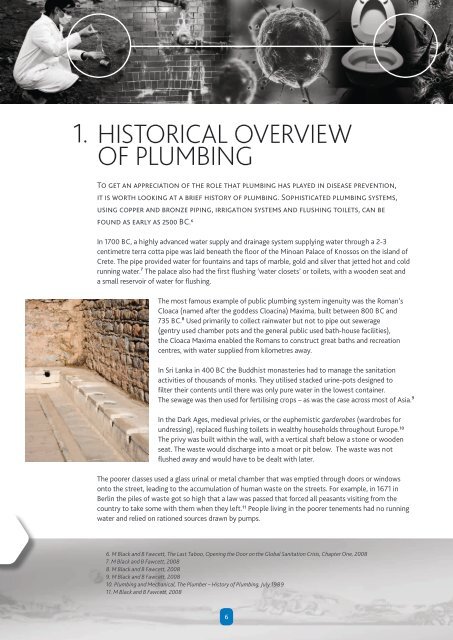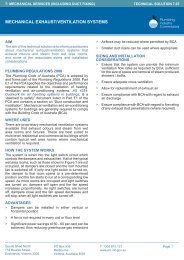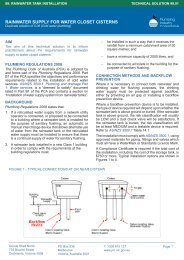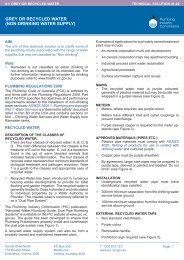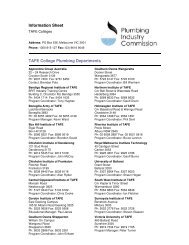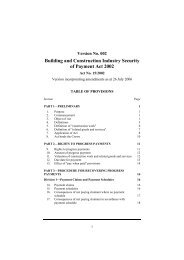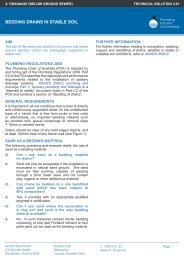current and emerging public health hazards - Plumbing Industry ...
current and emerging public health hazards - Plumbing Industry ...
current and emerging public health hazards - Plumbing Industry ...
You also want an ePaper? Increase the reach of your titles
YUMPU automatically turns print PDFs into web optimized ePapers that Google loves.
1.HISTORICAL OVERVIEWOF PLUMBINGTo get an appreciation of the role that plumbing has played in disease prevention,it is worth looking at a brief history of plumbing. Sophisticated plumbing systems,using copper <strong>and</strong> bronze piping, irrigation systems <strong>and</strong> flushing toilets, can befound as early as 2500 BC. 6In 1700 BC, a highly advanced water supply <strong>and</strong> drainage system supplying water through a 2-3centimetre terra cotta pipe was laid beneath the floor of the Minoan Palace of Knossos on the isl<strong>and</strong> ofCrete. The pipe provided water for fountains <strong>and</strong> taps of marble, gold <strong>and</strong> silver that jetted hot <strong>and</strong> coldrunning water. 7 The palace also had the first flushing ‘water closets’ or toilets, with a wooden seat <strong>and</strong>a small reservoir of water for flushing.The most famous example of <strong>public</strong> plumbing system ingenuity was the Roman’sCloaca (named after the goddess Cloacina) Maxima, built between 800 BC <strong>and</strong>735 BC. 8 Used primarily to collect rainwater but not to pipe out sewerage(gentry used chamber pots <strong>and</strong> the general <strong>public</strong> used bath-house facilities),the Cloaca Maxima enabled the Romans to construct great baths <strong>and</strong> recreationcentres, with water supplied from kilometres away.In Sri Lanka in 400 BC the Buddhist monasteries had to manage the sanitationactivities of thous<strong>and</strong>s of monks. They utilised stacked urine-pots designed tofilter their contents until there was only pure water in the lowest container.The sewage was then used for fertilising crops – as was the case across most of Asia. 9In the Dark Ages, medieval privies, or the euphemistic garderobes (wardrobes forundressing), replaced flushing toilets in wealthy households throughout Europe. 10The privy was built within the wall, with a vertical shaft below a stone or woodenseat. The waste would discharge into a moat or pit below. The waste was notflushed away <strong>and</strong> would have to be dealt with later.The poorer classes used a glass urinal or metal chamber that was emptied through doors or windowsonto the street, leading to the accumulation of human waste on the streets. For example, in 1671 inBerlin the piles of waste got so high that a law was passed that forced all peasants visiting from thecountry to take some with them when they left. 11 People living in the poorer tenements had no runningwater <strong>and</strong> relied on rationed sources drawn by pumps.6. M Black <strong>and</strong> B Fawcett, The Last Taboo, Opening the Door on the Global Sanitation Crisis, Chapter One, 20087. M Black <strong>and</strong> B Fawcett, 20088. M Black <strong>and</strong> B Fawcett, 20089. M Black <strong>and</strong> B Fawcett, 200810. <strong>Plumbing</strong> <strong>and</strong> Mechanical, The Plumber – History of <strong>Plumbing</strong>, July 198911. M Black <strong>and</strong> B Fawcett, 20086


